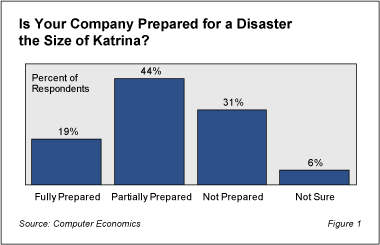In the aftermath of the worst Atlantic hurricane season on record, many companies are reviewing their IT disaster recovery plans to evaluate whether they are adequate for such a disaster, natural or otherwise. Hurricane Katrina is a case study of lessons learned: in particular, that companies must do more than provide a remote failover capability to keep critical IT business systems running. They must also plan to relocate key IT support personnel and key users to administer those systems.
This Research Byte is an extract of our full report, Disaster Recovery Lessons Learned from Hurricane Katrina.
Immediately after the Katrina disaster, Computer Economics polled visitors to its website regarding their ability to quickly recover from an event of a similar magnitude to Katrina. We asked “Is your company prepared to recover critical systems and data and temporarily relocate essential work groups in the event of a disaster the size of Hurricane Katrina?†The results of that informal study are revealing (Figure 1).

Only one-fifth of the respondents indicated that they are well-prepared. Such organizations would quickly recover critical business systems, would provide temporary work group recovery facilities, and would manage the logistics necessary to move key personnel and related tools to the designated recovery location. Nearly one-third of the respondents stated that they are clearly unprepared to handle an event as devastating as Katrina, while 6% of the organizations are currently unsure of their recovery capabilities.
However, what may be most disturbing is that nearly one-half (44%) of the respondents felt that they are “partially prepared†to handle an event of this magnitude. What makes this so unsettling is that disasters as severe as Katrina (and the record hurricane season that Katrina led) do not happen with any regularity. Therefore, many of these companies may decide to gamble that the cost of outfitting their organization for such events is unreasonable, based on the odds of an event of this severity affecting their region.
The full version of this report outlines the challenges that a regional Katrina-size disaster presents to the disaster recovery planner, including the challenges in relocating key support staff and user personnel. It also provides practical recommendations, based on government studies and current industry consensus, regarding both the minimum and maximum distances and geographic considerations for locating the disaster recovery data center site.
November, 2005
This Research Byte is a summary for our full report, Disaster Recovery Lessons Learned from Hurricane Katrina. The full report is freely available to Computer Economics subscribers, or it may be purchased by non-subscribers at the following link: https://avasant.com/report/disaster-recovery-lessons-learned-from-hurricane-katrina-2005/



